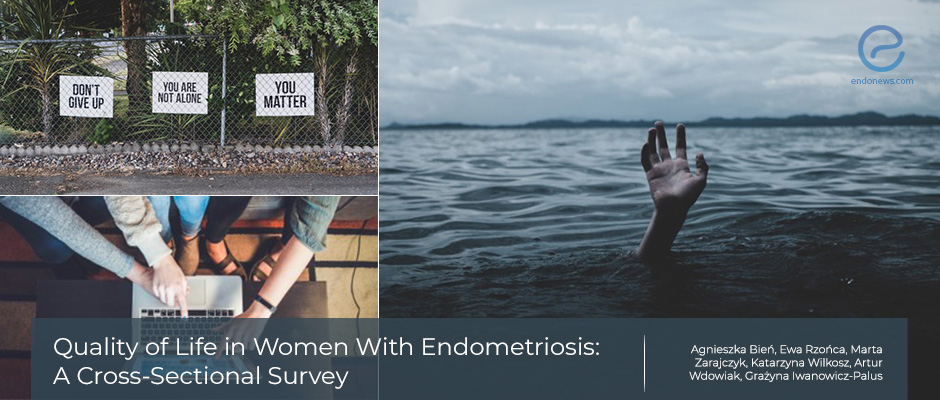The effect of endometriosis on the quality of life
Jun 29, 2020
Understanding the impact of endometriosis on quality of life will help in improving the treatment success.
Key Points
Highlights:
- Endometriosis has an impact on the quality of life of women including social, physical, psychological, and environmental aspects.
Importance:
- The quality of life of women with endometriosis should be assessed by the clinicians to determine their acceptance of the illness and to design a personalized treatment.
What’s done here?
- This cross-sectional survey was conducted to evaluate the quality of life of women with endometriosis and to analyze its determinants, conducted on 308 women in Poland in 2019.
- The inclusion criteria were having histologic confirmation of endometriosis, having stage 3 or 4 endometriosis (by revised ASRM), aged between 18-47.
- The socio-demographic characteristics including age, BMI, education level, relationship status, perceived family wealth were obtained from the standardized interview questionnaires.
- The WHO-QOL-BREF was used to evaluate the quality of life in physical, psychological, social relationships, environment, patient’s overall perception of their QoL and health.
- The "Acceptance of Illness Scale" was performed to assess the level of acceptance of illness.
- The Laitinen Pain Scale was used to measure the intensity and frequency of pain, the frequency of analgesic use, and physical activity limitations.
Key results:
- 213 patients (72.2%) thought that endometriosis had a negative effect on their relationship with their partner, 226 patients (73.1%) had dyspareunia during sexual intercourse.
- Menstrual pain disrupted daily functions of 247(85.8%) patients, and 288 (93.2%) had painful periods. The overall quality of life scores decreased among the participants.
- The psychological domain had the highest quality of life scores, while the physical domain had the lowest quality of life scores.
- The physical domain lowering the quality of life was associated with pain intensity, acceptance of illness, the impact of the illness on the relationship with the partner, and education.
- The psychological domain decreasing the quality of life scores was associated with acceptance of illness, obesity, the impact of the dysmenorrhea on daily functions, and dyspareunia.
- The predictors determining the social relationships domain in the quality of life were acceptance of illness, dyspareunia, the impact of symptoms on the relationship with the partner, and age.
- The predictors identifying the environmental domain were acceptance of illness, obesity, cost of endometriosis treatment, and perceived poor family wealth.
Strengths and Limitations
- This study was one of the few studies assessing the quality of life, acceptance of illness, and pain intensity in women with endometriosis.
- Inclusion of the patients with histologically confirmed stage 3 and 4 endometriosis is another strength.
- The cross-sectional design may be accepted as the limitation of this study.
- Not considering the patients’ gynecological history such as menstrual regularity, reproductive health, gestational history may be a limitation.
Lay Summary
Endometriosis, the disease defined as the localization of endometrial glandular and stromal tissue outside the uterine cavity, can be diagnosed in the reproductive-aged women with an incidence of 7-15%. However, endometriosis is observed in women with chronic pelvic pain syndrome and in infertile women much more frequently.
The main clinical finding of endometriosis is severe pain located in the lower abdomen during menstruation, sexual intercourse, urination, defecation, and gynecological examination. The daily routine of these women such as going to the school or work is usually affected during the painful periods, and all of these symptoms also impair the relationship with their partners and quality of life.
Bien et al, a group of scientists from Poland, published a cross-sectional survey titled “Quality of life in women with endometriosis: a cross‑sectional survey” in the journal named "Quality of Life Research". The authors aimed to evaluate the quality of life and define its determinants in women with endometriosis. For this purpose, they included reproductive-aged women with a diagnosis of histologically confirmed stage 3 and 4 endometriosis.
The WHOQOL-BREF evaluated the quality of life regarding the physical, psychological, social relationships, environment, patient’s overall perception of their QoL and health. The "Acceptance of Illness Scale" assessed the level of acceptance of endometriosis. The Laitinen Pain Scale determined the intensity and frequency of pain, the frequency of analgesic use, and physical activity limitations. According to the decreased scores of the overall quality of life among the participants, the authors concluded that endometriosis has detrimental effects on the quality of life of women with this disease. The highest and the lowest quality of life scores were obtained from the psychological and physical domains, respectively.
“Studies on patients’ subjectively perceived health may have an important cognitive, practical, and prognostic value and may thus help improve the quality of care of patients with diagnosed endometriosis. The present study on QoL in women with endometriosis shows variability in factors, indicating the need for a multidisciplinary, individual approach to a patient,” they added.
Research Source: https://pubmed.ncbi.nlm.nih.gov/32356276
endometriosis stage 3 stage 4 quality of life relationship with the partner dysmenorrhea dyspareunia acceptance illness pain intensity WHOQOL-BREF AIScale Laitinen Pain Scale

